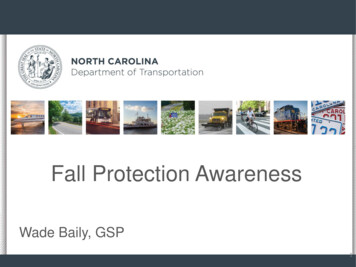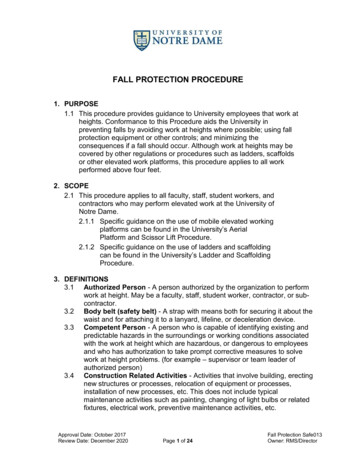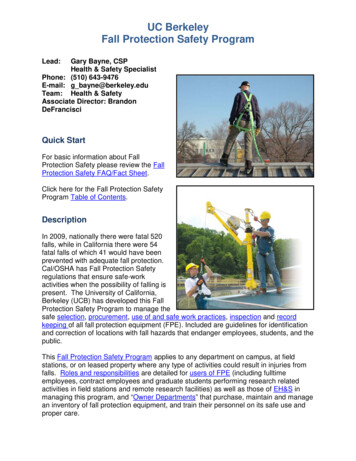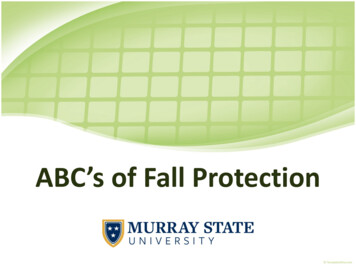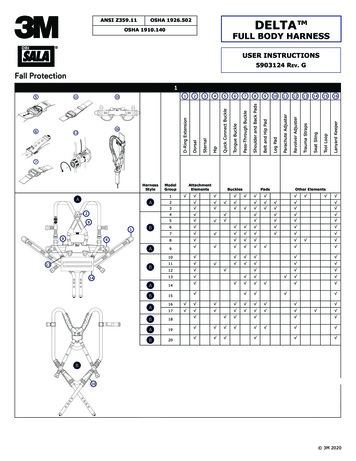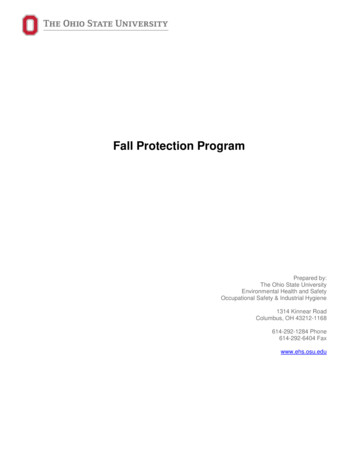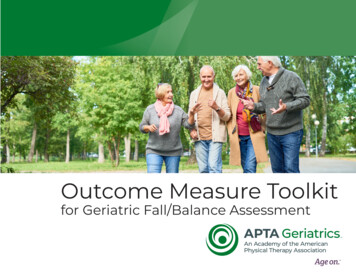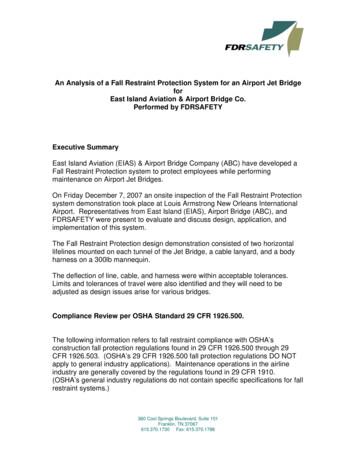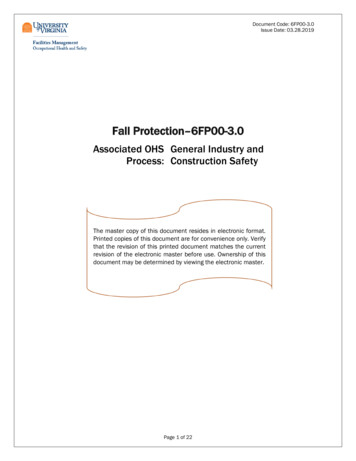
Transcription
Document Code: 6FP00-3.0Issue Date: 03.28.2019Fall Protection–6FP00-3.0Associated OHS General Industry andProcess: Construction SafetyThe master copy of this document resides in electronic format.Printed copies of this document are for convenience only. Verifythat the revision of this printed document matches the currentrevision of the electronic master before use. Ownership of thisdocument may be determined by viewing the electronic master.Page 1 of 22
Document Code: 6FP00-3.0Issue Date: 03.28.2019Table of Contents1.Summary . 41.1Objective . 41.2Scope . 42.Regulations & Other Requirements . 42.1Occupational Safety & Health Administration (OSHA) . 42.2University of Virginia . 42.3American National Standards Institute (ANSI). 43.Roles and Responsibilities . 43.1Facilities Management Occupational Health & Safety (FM-OHS) . 43.2Competent Person. 43.3Authorized Persons . 53.4Supervisor . 64.Fall Protection . 64.1Eliminating and Controlling Fall Hazards . 6Fall Hazard Hierarchy of Controls . 6Fall Hazard Elimination . 6Passive Fall Protection . 6Guardrail Systems . 6Guardrail examples . 7Fall Restraint Systems . 8Personal Fall Arrest Systems (PFAS) . 8Harnesses . 9Self-retracting lanyards, rope, and deceleration devices. 9Anchor points . 10Temporary Anchors . 10Permanent Anchors (post) . 11Permanent Anchors (Horizontal Lifeline) . 12Warning Lines . 12Designated Areas using Warning Lines. 13Lone Worker Policy . 144.2Special Circumstances . 144.3Protection from Falling Objects . 144.4Elevated Personnel Platforms . 145.Training . 156.Rescue . 15Page 2 of 22
Document Code: 6FP00-3.0Issue Date: 03.28.20197.Retraining . 168.Certification . 16Page 3 of 22
Document Code: 6FP00-3.0Issue Date: 03.28.20191.SummaryThe policy of Facilities Management (FM) at the University of Virginia (UVA) is to take every precautionarymeasure to protect the health and safety of all employees working at height and exposed to fall hazards.Implicit in the fall protection policy is the requirement that employees shall always be protected from falls to alower level when working at heights at or above the threshold indicated in this document.1.1ObjectiveThe purpose of this program is to provide fall protection procedures and concepts to prevent injury to FMemployees and other affected parties while performing work assignments at elevated working levels.1.2ScopeThis program applies to all University of Virginia Facilities Management employees when work assignmentsexpose them to fall hazards exceeding four (4) feet. This includes work considered industrial or construction innature.Potential fall hazards include floor openings, wall openings, holes in any working/walking surface, aerialplatforms, rooftop work, ladders, and any other task that may require employees to work at height.Contractor personnel operating on UVA property or projects are required to comply with this Fall ProtectionProgram or, alternatively, can adhere to their own Program if it is at least as effective as this document.2.Regulations & Other Requirements2.1Occupational Safety & Health Administration (OSHA)This Fall Protection Program complies with OSHA Standards 29CFR1910, Subpart D, Walking-WorkingSurfaces and 29CFR1926, Subpart M, Fall Protection2.2University of VirginiaThis Fall Protection Program complies with UVA-FM requirements.2.3American National Standards Institute (ANSI)(ANSI/ASSE) Z359 plays an integral part of this Program. Inherent in this ANSI standard are ‘MinimumRequirements for a Comprehensive Managed Fall Protection Program” as outlined in Z359.2.3.Roles and Responsibilities3.1Facilities Management Occupational Health & Safety (FM-OHS)a) Develop, administer, and annually review this Fall Protection Program.b) Provide observational safety checks of work operations and rigid enforcement of safety policiesand procedures.c) Coordinate training as required by this program.d) Provide consultation on work that requires fall protection as requested to include assistance withsuitable anchor points, PPE, job hazard analyses, and other fall protection strategies.e) Assist with inspection of jobsite areas and fall protection equipment.3.2Competent PersonWithin UVA Facilities Management there will be at least one person trained to the level of Competent Personfor each functional group that utilizes fall protection. A Competent Person is one who can identify and predicthazards and has the authority to take corrective action. Any project that uses fall protection should designatewhich person is acting as the Competent Person.Page 4 of 22
Document Code: 6FP00-3.0Issue Date: 03.28.2019The Competent Person shall be responsible for the immediate supervision, implementation, and monitoring ofthe Fall Protection Program. A Competent Person at UVA is typically a supervisor, lead, or other individualexperienced in fall protection and is in a position of authority. The number of Competent Persons required willvary according to the number and type of fall hazards, frequency of fall hazard exposure, and the distancesbetween fall hazard locations and facilities. The intent is that there is adequate supervision and support forAuthorized Persons performing work at height. Additional intent is to communicate that the frequency of a FallHazard Survey and/or procedures review is dependent upon how often the work is done, its complexity, theskills of the worker, and other factors. The review should be frequent enough to keep the Authorized Personadequately informed about the fall protection and rescue procedures for workplace activities.The responsibilities of this Competent Person will include, but not be limited to:a) Ensuring that employees in their functional group inspect their PPE prior to each use as well asannually;b) Providing copies of annual inspections to FM-OHS upon request c)d)e)f)g)All annual inspections should be completed in May of each year, but no later than May 31.Ensuring proper and adequate levels of training for members of their group;Verifying available fall clearance is adequate before Authorized Persons work at height;Ensuring that a prompt rescue can be performed;Immediately removing from service all personal fall protection systems and components that aredamaged;Conducting a fall hazard survey to identify all potential fall hazards before the Authorized Personsare exposed to those hazards. A Fall Hazard Survey allows the Competent Person to identify all fall hazards and otherassociated hazards and then provide specific means to control those hazards (PPE,engineering controls, etc.) as well as to account for rescue procedures.A Fall Hazard Survey should be completed whenever workers are exposed to falls that requireactive fall protection such as using a harness and lanyard or any other situation where themeans of fall protection are not passive (such as when there are already guardrails or otherbarriers in place).See the Fall Hazard Survey located in Appendix B of this document. A copy should becompleted by the Competent Person and kept at the jobsite until the completion of work.h) Stopping work immediately and taking prompt corrective measures to mitigate fall hazards;i) Preparing, updating, reviewing, and approving written fall protection procedures;j) Specifying in written fall protection procedures the selected systems, connecting means, bodysupports, and other fall protection equipment that authorized persons are required to use whenthey are exposed to fall hazards.3.3Authorized PersonsAuthorized Persons shall ensure they have and use the fall protection equipment as required by this programand:a) Understand the potential hazards of working at elevated levels as well as when gaining access toand from the work location;b) Pre-plan the job with his/her supervisor to agree that the job can be done safely;c) Understand the use and limitations of fall protection equipment;d) Understand when to bring to the Competent Person’s attention all unsafe or hazardousconditions, actions, or unsafe work practicese) Inspect such equipment before each use and to report defective equipment immediately to theirsupervisorPage 5 of 22
Document Code: 6FP00-3.0Issue Date: 03.28.20193.4SupervisorThe supervisor shall ensure that they provide full support to Authorized and Competent Persons and commit toensuring the safety of those individuals when working at height. The Supervisor should:a) Ensure that fall protection equipment is available and in safe working condition;b) Ensure that all employees have required training;c) Communicate upcoming projects that require active fall protection to Competent Persons andOHS as necessary.4.Fall Protection4.1Eliminating and Controlling Fall HazardsFall Hazard Hierarchy of Controlsa) The fall hazard hierarchy of controls should be considered when designing fall protection solutionsfor both existing and new facilities. The methods listed below are in decreasing order ofpreference:1)2)3)4)5)Prevent or eliminate exposure through design that disallows fall exposuresPassive fall protection (guardrails and parapets)Fall Restraint SystemsFall Arrest SystemsAdministrative Systems (warning lines)Fall Hazard EliminationFall hazards can be prevented or reduced by effectively eliminating the hazard through severalmethods. For example:a) Complete as much work on the floor or ground as possible to eliminate or reduce the time workingabove ground;b) Build and lift sub-assemblies into place rather than placing piece-by-piece above the ground;c) Establish an effective guard railing system or walls that are at least 39 inches high.Passive Fall ProtectionPassive fall protection requires no action by the user to be effective. It is important, however, that whenpassive fall protection is used that the parameters of that system meet all OSHA requirements as indicated inthis document. Examples of passive fall protection include guardrails and parapets. Note that parapets mustbe at least 39 inches tall to be considered suitable for fall protection.Guardrail Systemsa) Every open-sided floor or platform 4 feet or more above adjacent floor or ground level shall beguarded by a standard railing on all open sides except where there is entrance to a ramp,stairway, or fixed ladder.b) The railing shall be provided with a toeboard wherever, beneath the open sides, persons can pass,there is moving machinery below, or there is equipment with which falling materials could create ahazard.c) A standard railing shall consist of top rail, intermediate rail, and posts, and shall have a verticalheight of 42 inches nominal from upper surface of top rail to floor, platform, runway, or ramplevel.d) The top rail shall be smooth-surfaced throughout the length of the railing. The intermediate railshall be approximately halfway between the top rail and the floor, platform, runway, or ramp. Theends of the rails shall not overhang the terminal posts except where such overhang does notconstitute a projection hazard.Page 6 of 22
Document Code: 6FP00-3.0Issue Date: 03.28.2019e) For wood railings, the posts shall be of at least 2-inch by 4-inch stock spaced not to exceed 6 feet;the top and intermediate rails shall be of at least 2-inch by 4-inch stock. If top rail is made of tworight-angle pieces of 1-inch by 4-inch stock, posts may be spaced on 8-foot centers, with 2-inch by4-inch intermediate rail.f) For pipe railings, posts and top and intermediate railings shall be at least 1 1/2 inches nominaldiameter with posts spaced not more than 8 feet on centers.g) For structural steel railings, posts and top and intermediate rails shall be of 2-inch by 2-inch by3/8-inch angles or other metal shapes of equivalent bending strength with posts spaced not morethan 8 feet on centers.h) The anchoring of posts and framing of members for railings of all types shall be of suchconstruction that the completed structure shall be capable of withstanding a load of at least 200pounds applied in any direction at any point on the top rail.i) A standard toeboard shall be 4 inches nominal in vertical height from its top edge to the level ofthe floor, platform, runway, or ramp. It shall be securely fastened in place and with not more than1/4-inch clearance above floor level. It may be made of any substantial material either solid orwith openings not over 1 inch in greatest dimension.j) Guardrail systems may be temporary and erected for specific tasks. They must meet the sameheight and performance requirements as permanent guardrails.k) Guardrail height must be adjusted to accommodate the height of stilts, if they are in use.Guardrail examplesPage 7 of 22
Document Code: 6FP00-3.0Issue Date: 03.28.2019Ballasted guardrail.Parapet clamp.Fall Restraint SystemsWhere workers must work at an elevated working surface while exposed to fall hazards and a guardrail systemisn’t feasible, a fall restraint system may be considered, if appropriate. A fall restraint system is arranged to notallow the worker to reach the edge where a fall is possible. Fall restraint systems require:a) A Competent Person to assess the work area to ensure that a fall restraint system is feasible andto assist the worker in designating a suitable anchor point and system components.b) A connecting lanyard that is adjusted to a length that will not allow the worker to reach the edgewhere a free fall is possible.c) A full-body harness.d) An anchor system that is rated to at least 3000 lbs for standard restraint system.Personal Fall Arrest System v. Fall Restraint SystemPersonal Fall Arrest Systems (PFAS)Personal Fall Arrest Systems (PFAS) are designed to protect workers that suffer a fall. PFAS employ the use of afull-body harness, a connecting lanyard and a suitable anchor point.Page 8 of 22
Document Code: 6FP00-3.0Issue Date: 03.28.2019a) All fall protection equipment must meet applicable ANSI and OSHA standards.b) The anchor point must be capable of supporting at least 5000 lbs for each employee attached.c) The fall arrest system shall be rigged such that an employee can neither free fall more than 6 feet,nor contact any lower level.d) Preference shall always be for the use of a self-retracting lanyard (SRL), due to the greater limit tofree-fall and the shorter deceleration distance.e) The fall arrest system shall bring an employee to a complete stop and limit maximum decelerationdistance an employee travels to 3.5 feet. ALL fixed-length lanyards used by UVA workers will beequipped with a deceleration device designed to reduce the arresting forces on the body to lessthan 900ft/lbs.f) The anchor point should be overhead and as close as possible to reduce fall arresting forces inthe event a fall should occur. If an anchor point cannot be located overhead, then a self-retractinglanyard (SRL) is required to be used.g) Avoid anchor points where a fall may result in a pendulum motion that could cause serious injury.h) All fall protection equipment must be inspected and used as per the manufacturer.Calculating Fall Distance When Using a Personal Fall Arrest System.HarnessesObtaining the correct fit of a harness is vitally important. A harness that doesn’t fit properly, or is wornimproperly, is less likely to be used. Harnesses should be inspected before each use and an annual inspectionshould be conducted and documented. Use the inspection checklist located in Appendix C of this document.The following should be considered when using and maintaining harnesses:a) Properly store harnesses in a location that is free from moisture and away from extreme temperatures.It is recommended that harnesses be stored by hanging or laying flat or neatly folded.b) Most harnesses are rated for users that are between 130 and 310 pounds. Contact FM-OHS ifassistance is needed for users that fall outside of that range.c) Fall protection harnesses have a usable service life of five years from the date they were placed inservice. The date placed in service should be written on the embedded tag on every harness.d) Harnesses are available for either gender and consideration should be made for that as well as anyother instances where a traditional harness may not be the best option. Contact FM-OHS for moreassistance.Self-retracting lanyards, rope, and deceleration devicesPage 9 of 22
Document Code: 6FP00-3.0Issue Date: 03.28.2019Self-retracting lanyards (SRL) are available in a variety of configurations: single and double legged made ofcable, synthetic webbing, or rope. Whenever possible, SRL should be used with the anchor point overhead. Inthe event an overhead anchor is not possible, then an SRL can still be used but extra care must be taken toensure adequate room is available for swing fall. Additionally, it is important that the user is aware of differentSRL classifications as follows: Standard SRL – best used for situations where the free fall is two feet or less and there are noobstructions and the anchor is overhead.SRL – R – This SRL has ‘rescue’ capabilities where the user can activate a mechanism that can slowlylower them to the ground. These are available upon request at UVA-FM. Contact OHS for assistance.SRL – LE – These SRLs are designed to be used on leading edges or whenever the anchor is at footlevel. These devices can resist cutting if falling over a sharp edge.Additionally, SRLs are in two classes: Class A – allow for a maximum of 24” deceleration distance and average arresting force of 1350pounds.Class B – allow for maximum of 54” deceleration distance and average arresting force of 900pounds.If not using an SRL, then an energy absorbing lanyard MUST be used. These lanyards are typically six feet inlength and may come with one or two legs. If a worker is wearing a six foot lanyard, then that worker could freefall then entire six foot length before the energy absorber engages which typically adds another 3.5 feet to thefall distance. Therefore, it’s critical to understand the amount of fall distance available before using an energyabsorbing lanyard.Anchor pointsSelecting a proper anchor point can be a challenge. There are many types of anchor points commerciallyavailable, in addition to anchor points that may already be integral to a given structure. A Competent Personshould assess each personal fall arrest system for a suitable anchor point(s). Contact FM-OHS for assistance ifneeded.Two anchor point load requirements are referenced by OSHA. If using a lanyard with a shock absorber, thenthe anchor must be able to support 5,000 pounds per person attached. Additional options are provided wherethe anchor can support two times the intended load as determined by a Qualified Person. Contact FM-OHS atall times in these instances.There are also provisions available where, when using a self-retracting lanyard, an anchor point has a loadbearing capacity of 3,000 pounds. However, the minimum requirement at UVA is 5,000 pounds unlessanalyzed by a Qualified person.Anchor points can be divided into ‘Temporary’ or ‘Permanent’. Examples of each are found below:Temporary AnchorsPage 10 of 22
Document Code: 6FP00-3.0Issue Date: 03.28.20191.Residential Anchor Straps.2. Concrete Anchors.3. Standing Seam Roof System.4. Beam strap.5. Ballasted roof anchors.6. Beam clamps.Permanent Anchors (post)Page 11 of 22
Document Code: 6FP00-3.0Issue Date: 03.28.2019Permanent roof anchors can be anchors that were installed for the specific purpose of being a fall protectionanchor or a permanent roof anchor could be an integral part of a given structure. Typically, a structuralmember such as a loan-bearing column or beam can be a suitable anchor point. However, a CompetentPerson must make that determination. Consult FM-OHS if more assistance is needed. There are an everincreasing number of buildings on the UVA campus that make use of permanent anchors that are installedduring new construction, during renovations, or upon request. Most of these anchors are intended for oneuser.Below are some examples of permanent roof anchors:Permanent Anchors (Horizontal Lifeline)There are several horizontal lifelines installed on rooftops on the UVA campus. These are typically intended forone user at a time only. These lifelines can be used either as fall restraint or fall arrest. If used for fall arrest,an SRL is the lanyard of choice. Consider whether a double-legged lanyard would be required to maneuveraround vertical supports on the lifeline. Consult FM-OHS if assistance is needed when using these lifelines.Horizontal lifeline on Runk Dining HallWarning LinesWarning lines, when used properly, are an option for flat roofs for both roofing work and non-roofing work.Important distinctions between the two types of work are as follows:a) If work is non-roofing in nature, a warning line system can be no closer than 15 feet from theedge. If a worker must proceed outside of the warning line, then they must be protected by apersonal fall arrest system or guardrail (see Note in this section).b) For roofing work, warning lines may be placed no less than six feet from the edge. If a workerproceeds outside of these warning lines, then they must be protected by a personal fall arrestsystem or guardrail.c) Note: There are allowances for warning lines for non-roofing work to be placed six feet from theedge. See Designated Areas.Page 12 of 22
Document Code: 6FP00-3.0Issue Date: 03.28.2019Designated Areas using Warning LinesEmployees may establish designated areas which comply with the provisions of this paragraph as analternative to installing guardrails, where the Competent Person demonstrates that employees within thedesignated areas are not exposed to fall hazards. In addition, the following conditions and requirements mustbe met in order to use designated areas in lieu of other fall protection measures:a) The work must be of a temporary nature, such as maintenance on roof top equipment.b) Designated areas shall be established only on surfaces that have a slope from horizontal of 10degrees or less.c) The designated area, or any other area where warning lines are used, shall consist of rope, wire orchain and supporting stanchions erected in accordance with the following criteria:1) Strengthd) After being erected with the line (such as rope, wire or chain) attached, stanchions shall becapable of resisting, without tipping over, a force of at least 16 pounds (71 N) appliedhorizontally against the stanchion. The force shall be applied 30 inches (76 cm) above thework surface and perpendicular to the designated area perimeter, and in the direction of theunprotected side or edge;e) The line shall have a minimum breaking or tensile strength of 500 pounds (2.2 kN), and afterbeing attached to the stanchions, shall be capable of supporting the loads applied withoutbreaking; andf) The line shall be attached at each stanchion in such a way that pulling on one section of theline between stanchions will not result in slack being taken up in adjacent sections before thestanchion tips over.2) Heightg)The line shall be installed in such a manner that its lowest point (including sag) is no less than34 inches (86 cm) nor more than 39 inches (1 m) from the work surface.3) Visibilityh) The line forming the designated area shall be clearly visible from any unobstructed locationwithin the designated area up to 25 feet (7.6m) away, or at the maximum distance a workermay be positioned away from the line, whichever is less. (One method for meeting the visibilitycriteria for designated areas is to place a flag made of high visibility material on the rope, orwire or chain at not more than six-foot (1.8 m) intervals.)4) Locationi)j)k)The stanchions shall be erected as close to the work area as is permitted by the task.The perimeter of the designated area shall be erected no less than six feet (1.8 m) from theunprotected side or edge.Access to the designated area shall be by a clear path, formed by two lines, attached tostanchions, which meet the strength, height and visibility requirements of this paragraph.Page 13 of 22
Document Code: 6FP00-3.0Issue Date: 03.28.2019Figure 1: Designated AreaLone Worker PolicyIn any situation where a Facilities Management employee is utilizing a fall arrest system for fall protection,there must be at least one other worker present to notify emergency services if needed. If it is infeasible tohave a second worker available, then a second person must be notified.4.2Special CircumstancesRoof hatches, when left open, constitute a fall hazard. To eliminate the fall hazard, roof hatches must be keptclosed while the work is underway unless the hatch opening is protected by guardrails.Skylights also represent a fall hazard. When working on or in proximity of skylights, either the skylightseffectively covered, protected with permanent or temporary guardrails or workers must wear a restraint systemor PFAS.4.3Protection from Falling Objectsa) When employees are required to work in proximity of others working with materials, tools, orequipment at elevated levels, barricades shall be erected around the immediate area of theoverhead work to prohibit employees and pedestrians from entering the area where they could beexposed to overhead hazards.b) Employees performing work at elevated levels shall keep tools, materials, and equipment awayfrom the edge to keep potential objects from falling over the side. Where practical, tools, etc.shall be secured wi
a) Ensure that fall protection equipment is available and in safe working condition; b) Ensure that all employees have required training; c) Communicate upcoming projects that require active fall protection to Competent Persons and OHS as necessary. 4. Fall Protection 4.1 Eliminating and Controlling Fall Hazards Fall Hazard Hierarchy of Controls
